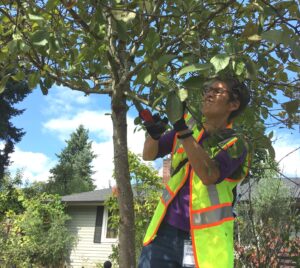Community Pruning in Eugene
Community Pruning—An Art and a Science
The Eugene Branch is in the heart of its pruning season, and has already hosted several successful community pruning events. They’ve been keeping these pruning events small and intimate so that each volunteer gets more hands-on experience. Pruning can feel like an art as much as a science, and it’s something that takes a lot of practice before you feel comfortable with it.
“We’ve had smaller pruning events in recent years because of Covid,” says Taylor Glass, Eugene-Springfield Program Manager for Friends of Trees in Eugene. “We decided to keep it small because the pruners really appreciate it.”
Each pruning event has just 15 volunteers, and they split into five groups, with one Friends of Trees staff member on each team. They prune to provide clearance over the sidewalk and the road, and they prune for good structure. In many but not all species, this includes encouraging a strong central leader.

One reason that Eugene prunes in late summer, rather than in the dormant season, is that it slows the trees down. “Here, fast growth is a bigger issue than slow growth,” Erik says. Fast growing trees are tougher to manage for strength and stability, and will often have weaker wood more prone to failure, particularly in snow or ice storms, which is something you don’t want in the urban environment.
“Young tree pruning is the most cost effective thing you can do for an urban forest,” says Eugene Director Erik Burke. Pruning helps create a lasting form that won’t suffer as much damage from storms and trucks.
When you walk up to a tree that needs to be pruned, it can be tough to know where to start. Every tree is different. You have a number of goals you want to achieve, but you can only prune so much. Each pruner might make different little decisions toward the same overall goal of forming the tree.
“It’s so personal, the approach each person takes,” Erik says. “We all do it totally differently and no one way is right.”
The small pruning teams allow for a collaborative decision-making process, which grows a volunteer’s experience and confidence. And with experience and confidence, a small team can accomplish just as much as a big group.
“Volunteers can be anxious, because they want to do it right,” says Erik. “But the trees are resilient, and they’ll be fine in the long run.”
Ideally a tree gets pruned every three years for the first fifteen years of its life. We’re not always able to provide every tree with the ideal number of prunings, but thanks to volunteer efforts, we can often give trees pruning attention that they need.
Pruning a tree can be really satisfying, when you step back and look at its form take shape. And it can be especially rewarding when you see the tree grow into that form over the years. Giving volunteers hands- on involvement in the process creates a special bond to these community trees, and volunteers always want to come back to do it again.
“Teaching is a great way to learn,” Taylor says. “And with each season, you learn more.”

